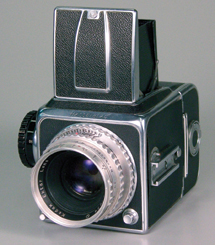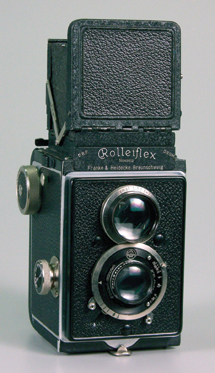Classic Cameras; The Top 20 Cameras Of All-Time Countdown; Schneider’s List, The Next Five–Do You Agree? Page 2
12) Hasselblad 1600F--1948
 |
The first modern, modular 6x6cm- (21/4 square-) format SLR, the original 1600F,
designed under the direction of Victor Hasselblad, has proven to be a remarkably
enduring and influential design. The current line of V-series Hasselblad cameras
(e.g., the 500 C/W) are still based on the same elegant, modular concept of
a boxy, cast alloy body with stainless steel inner chassis, interchangeable
film magazines at the back, slide-in viewfinders on top, and a wide range of
Carl Zeiss bayonet-mount lenses at the front. The only major differences: The
1600F incorporated a corrugated stainless steel focal-plane shutter with speeds
of 1 second to 1/1600 sec plus B and its lenses were preset because the body
had no internal auto-diaphragm actuation. Nevertheless, the exquisitely made
Swedish camera created a sensation when it was announced in 1948, and it soon
became the darling of professional photographers, both in field and studio,
because of its compact, well-balanced design.
Despite its sterling qualities and excellent imaging capabilities, the 1600F's
shutter was plagued by accuracy and reliability problems, which paved the way
for the Hasselblad 1000F (with improved metal focal-plane shutter with 1/1000
sec top speed) in '52. The biggest change came with the Hasselblad 500C
of '57--the progenitor of the current V-series.
Additional Hasselblad 1600F features include knob wind, a hinged port at the
rear of the film magazines for first-frame positioning, removable flip-up waist-level
viewing hood with flip-up magnifier, replaceable with slide-in prism finder,
and bayonet-mount Kodak Ektar lenses. Normal lens is the 80mm f/2.8 Ektar, and
the line included the 55mm f/6.3 Wide Field Ektar, 135mm f/3.5 Ektar, and 254mm
f/5.6 Ektar, all "Lumenized," that is, coated on all air-glass surfaces.
Among the many cameras influenced by the Hasselblad 1600F: Square-format Bronicas
from Japan, the Rolleiflex SL66 from Germany, and the Ukrainian Kievs, unabashed
copies of the Hasselblad 1000F. Hasselblad 1600Fs are very thin on the ground
and avidly collected, and lenses other than the 80mm f/2.8 Ektar and 135mm f/3.5
Ektar are virtually impossible to find. A clean, functional 1600F with 80mm
f/2.8 Ektar lens and standard film magazine sells for $3000 and up; a complete
outfit, for well over $10K.
11) Rolleiflex (Original Model)--1929
 |
The first rollfilm Twin-Lens Reflex (TLR) camera ever offered for sale, the
original Rolleiflex, made by Franke & Heidecke, of Braunschweig, Germany,
is not only the ancestor of all subsequent Rolleiflex and Rolleicord TLRs made
by the same company, but also of literally hundreds of different TLR models
produced in practically every industrialized country of the world from the 1930s
through the present. Aside from the humble box camera, no camera design has
ever been so thoroughly flattered by imitation. The original Rolleiflex resulted
from implementing the ingenious idea of taking the company's Rolleidoscop
rollfilm stereo camera of '26 (which had a viewing lens and reflex finder
placed in between the two picture-taking lenses) and reconfiguring it by placing
the viewing lens and finder atop a single taking lens. This yielded a nicely
balanced, ergonomic design, providing many of the viewing and focusing advantages
of an SLR while eliminating much of the complexity. It was an instant success,
and the upstart Rolleiflex soon outsold Franke & Heidecke's earlier
cameras by a wide margin. By '32, a much improved Rolleiflex, the (old)
Standard was introduced. It had crank wind, more convenient controls, and an
eye-level sportsfinder built into the viewing hood. (For more on Rollei's
history, see my #17 pick, the Rolleiflex Automat of '37.)
The original Rolleiflex is a beautifully made but Spartan beast, with knob wind,
red window frame counter, early rim-set Compur leaf shutter with speeds of 1
second to 1/300 sec plus B and T, 75mm f/4.5 or (more commonly) 75mm f/3.8 Carl
Zeiss Tessar taking lens and 75mm f/3.1 Heidoscop-Anastigmat viewing lens. The
film size was 117 (basically 120 film on a narrower-flanged spool) but the format
was 6x6 (21/4 square) and some were converted to take 120 film. It's a
fine picture taker but its viewfinder is quite dim by modern standards. An original
Rolleiflex in clean working condition is a scarce collector's piece, but
considering its historical significance, its typical selling price is a fairly
modest $300-$400.
The Top 20 Cameras Of All-Time |
|
| 20) Kodak Instamatic 100 - 1963 | 10) ????? |
| 19) Reflex-Korelle - 1935 | 9) ????? |
| 18) Hansa Canon - 1935 | 8) ????? |
| 17) Rolleiflex Automat - 1936 | 7) ????? |
| 16) Zeiss Contax II - 1936 | 6) ????? |
| 15) Asahiflex IIB--1954 | 5) ????? |
| 14) Sony Mavica--1981 | 4) ????? |
| 13) Contax S--1949 | 3) ????? |
| 12) Hasselblad 1600F--1948 | 2) ????? |
| 11) Rolleiflex (Original Model)--1929 | 1) ????? |
Next in the Countdown 10-5 |
|
- Log in or register to post comments

































